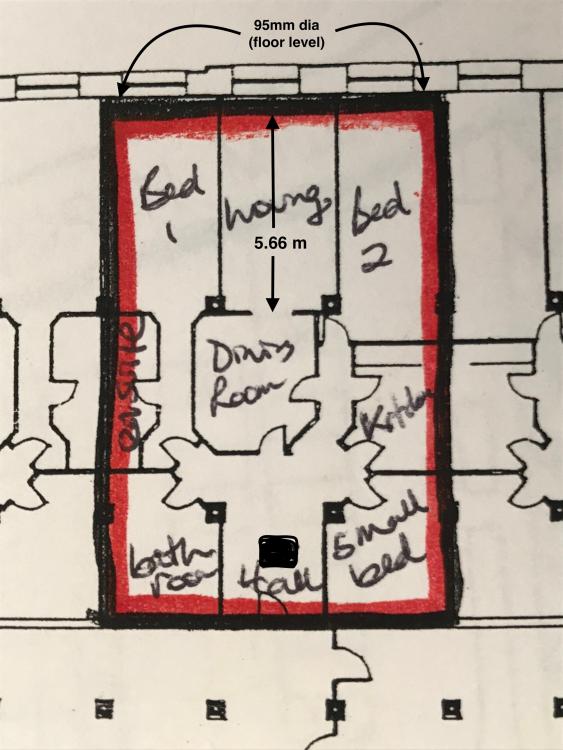Search the Community
Showing results for tags 'iwi'.
-
Hi folks, We're remodelling our ~1990s built two storey, end of terrace home, and I'd like to improve our current wall insulation, since at present it offers the least thermal resistance of the building fabric. I'm interested in recommendations on approach we can take to improve this. Walls Current: Brick / cavity / block walls with some questionable looking EPS boards in the cavity. Dot and dab plasterboard on the inner block. Plan: Help! 😬. I've read a lot of conflicting information about whether internal insulation is suitable or will cause interstitial condensation. Also not sure of the most cost effective construction method (insulated plasterboard on dabs, insulated wet plaster etc...) There would be roughly 34 linear metres of wall to insulate per floor, at 2.4 m ceiling height. I’d like to focus on simple and practical solutions that we can relatively easily implement. The underlying work for our builder is to reconfigure the layout involving some light structural changes, and construct a porch area (all on ground floor of property). We're having the heating system pipework upgraded to suit low flow temperatures and fitting an ASHP. Any disruptive works (e.g. plasterboard off) would be constrained to ground floor initially, and could be extended to first floor as a phase 2 at a later date. Construction materials are: Ground Floor Current: Uninsulated beam and block, battens, chipboard deck. Plan: Lay DPM / PIR / floating floor deck on top of beam and block. First Floor Current: Chipboard deck suspended on timber joists. Plan: Nothing so far. Roof Current: Pitched roof / cold loft, around 100 mm wool insulation already laid. Plan: Increase to ~300 mm wool insulation. Happy to hear everyone's thoughts and advice 🙏
-
I stumbled on this site while researching MVHR and saw some great discussions and expertise. I have a 112 m2 top floor flat part of a mill converted in 1995. I am looking at sensible upgrades for the next 10-15 years. Presently I have Electrical heating (1995 storage heaters) 12000 kWh pa , aluminium double glazing from 2010 (3 x 6 panel windows 2.3mx1.6m), have heard mention that frames are not thermally efficient, thick solid stone walls (580mm window returns) insulation status unknown, 3.5m high ceilings lounge hallway and bedrooms, observed 200mm loft insulation. Lounge and bedrooms are long and narrow and perhaps not well suited to present (lack of ventilation) Perhaps the biggest immediate concern for next winter is high CO2 levels (measured by Awair sensor) in the flat unless windows are opened. It also gets very stuffy in summer and I suffer from hay fever. There is no vent fan (apart from cooker hood with activated carbon filter) in the kitchen. Its been blocked up probably because the flexible trunking collapsed(a neighbour experienced this). The only connections to the outside are two 95mm?(100 nominal?) holes through the stone work which are connected through boxed in trunking along the floor (wouldn't mind moving it up to reclaim floor space) to kitchen (originally) on one, and 2 bathrooms on the other. The bathroom fans suck but no perceptible flow at outside of building. Maybe disconnected by previous owner and routed into loft space (on the other side of a fire division - not good) I am thinking that PIV system might be best rather than MVHR due to forum mentions on air leakage, although a lot of it might be beneficial in terms of heat input... The available 95mm openings are in bedrooms and I need to minimise cold piping, Can I use one opening for fresh air and one to take kitchen and 2 bathrooms out. Or is there a way to alternate (breathe in, breathe out, like ....lungs...) For moisture control, I tend to finish the timed laundry for when I can use the dehumidifier on Economy 7 for a couple of hours in the morning (early riser). I see the dehumidifier as effectively free to run as I have electric heating anyway. Seeking expert commentary, please, especially on whether I can get good ventilation with the two 95mm openings to the outside. Can I anyone recommend an approach and contacts for HVAC design?
- 2 replies
-
- ventilation
- iwi
-
(and 5 more)
Tagged with:
-
Not sure if it’s ridiculous to consider solid walls for a new build. I have done a lot of googling on the subject, it seems you can get a decent U value without the wall being too thick, some suggesting even thinner than would be required with cavity walls! Im considering it because there is a flood risk, and I believe solid walls are preferable in this situation, water in the cavity wouldn’t be pleasant even if I chose closed cell insulation. Other positives could be, depending on route chosen, dense block work could be a great sound barrier, or it opens up the possibility of more interesting brick bonds. Have double the bricks would be pretty expensive though. I can’t work out if condensation is a risk, some people say it is a risk with solid walls, others think cavity wall insulation will be the next ppi for its damp risks.. That brings me on to the next thing internal or external wall insulation, it seems external is preferable, however internal offers the chance to have more interesting brick work. In my mind I think external would be more effective, however with external surely you will lose a lot of energy heating the dense blocks? You wouldn’t have this with internal insulation. Hmmm. Going around in circles with this one!
- 30 replies
-
My partner and I recently bought a small cottage near Forres in Scotland. It has a concrete floor slab and thick masonry walls. I've been planning to add a layer of insulation to the inside of my house but have found guidance on this to be a bit vague. Some suggest that a permiable insularion should be used others a vapour barrier. There is a threat that if the wrong approach is taken damp / condensation could result. I'm hoping to hear from people who have insulated their walls successfully. What method of insulation was used? Any input or suggestions welcomed.
-
Hi all i am really keen to get great sound and heat insulation, searching on here if I see many have timber frame or other construction methods. I was wondering what the best way if achieving good results with a brick and block construction? I dont really have extra space for thicker floors or walls to pad it out with extra insulation, maybe there is higher spec material I can use etc? any way tips are massively appreciated
- 19 replies
-
- new build
- brick block
-
(and 2 more)
Tagged with:
-
I've got a question on the addition of IWI to an existing structure. We have an existing building that is remaining, and I've discovered that the cavity is insulated (unusual for a double garage !) and therefore the plan to add blown bead to the cavity has now gone out of the window. So I have 65mm cavity that appears full filled with fibre so we will need to add 70mm of PIR to the inside rather than the 50mm we were expecting. That now adds a question as to how to achieve this..? I had considered using a 50mm layer which is secured back with low expansion foam and then 50x25mm battens screwed to the wall to mechanically secure it, filling the 25mm gap with a second layer of PIR between the battens. This allows me to also include a service void if needed in the 25mm insulation layer. Have I missed a better way that doesn't need battens and lots of ling fixings...??


